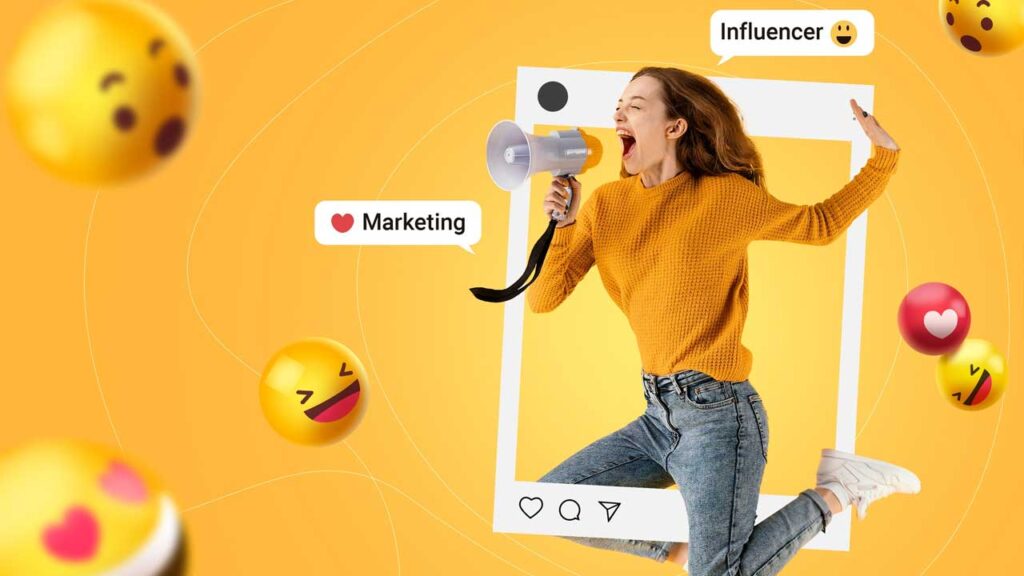Social media is a powerful way to grow your brand and reach more customers. But how do you create a social media presence that stands out from the crowd? In this article, you will learn the best strategies for picking the right platforms, crafting captivating content, building connections, and tracking your progress.

What is Social Media Presence and Why is it Important?
Your social media presence is how you showcase your brand and interact with your audience on different social media platforms. It includes your profile, content, interactions, and the impact you have on your audience. For individuals, it’s about creating an authentic online persona. For businesses, it’s a vital part of brand identity and customer engagement.
Having a strong social media presence is crucial for your brand’s growth and credibility, as it can help you:
- Increase brand awareness and reach new potential customers
- Gain audience insights and understand their needs, preferences, and expectations
- Generate user-generated content and leverage social proof and testimonials
- Achieve your business goals such as increasing sales, leads, or traffic
In this article, you will learn how to create a powerful social media presence for your brand by following these steps:
- Set SMART goals for your social media strategy
- Know your audience better
- Be consistent with your brand’s voice and aesthetic
- Create a social media calendar and use different types of content
- Stay relevant with current events and social issues
- Encourage user-generated content from your customers
- Focus on quality over quantity when it comes to followers and engagement
Setting SMART Goals for Your Social Media Strategy
The first step to creating a powerful social media presence is to set SMART goals for your social media strategy. SMART stands for specific, measurable, achievable, relevant, and time-bound. These criteria help you define clear and realistic goals that are aligned with your overall business objectives.
What are SMART goals?
SMART goals are a way of setting objectives that are:
- Specific: They state what you want to achieve and how. They answer the questions of who, what, where, when, why, and how.
- Measurable: They have a quantifiable indicator of success. They answer the question of how much or how many.
- Achievable: They are realistic and attainable. They answer the question of how you can accomplish them.
- Relevant: They support your business vision and mission. They answer the question of why they matter.
- Time-bound: They have a deadline or a timeframe. They answer the question of when you will achieve them.
Why are SMART goals important?
SMART goals can help you focus your efforts, track your progress, and achieve your desired outcomes. By setting SMART goals, you can:
- Clarify your expectations and priorities
- Motivate yourself and your team
- Monitor your performance and results
- Celebrate your achievements and learn from your failures
- Adjust your strategy and actions as needed
How to set SMART goals for your social media strategy?
To set SMART goals for your social media strategy, you need to:
- Analyze your current situation and identify your strengths, weaknesses, opportunities, and threats (SWOT analysis)
- Define your target audience and understand their needs, preferences, and behaviors
- Determine your social media objectives and align them with your business goals
- Choose the best social media platforms and tools for your brand and audience
- Create SMART goals for each social media platform and objective
- Implement your social media plan and measure your results
- Review your performance and optimize your strategy
Example of a SMART goal for social media
A SMART goal for social media could be:
Increase Instagram followers by 10% in three months by posting high-quality photos and videos, using relevant hashtags, and engaging with potential customers.
This goal is:
- Specific: It states what you want to achieve (increase Instagram followers) and how (posting high-quality photos and videos, using relevant hashtags, and engaging with potential customers).
- Measurable: It has a quantifiable indicator of success (10% increase in followers).
- Achievable: It is realistic and attainable (it is based on your current performance and resources).
- Relevant: It supports your business vision and mission (it helps you reach more potential customers and increase brand awareness).
- Time-bound: It has a deadline or a timeframe (three months).
Setting SMART goals can help you create a powerful social media presence that drives your business growth. By following the SMART criteria, you can ensure that your goals are clear, realistic, and aligned with your overall business objectives.
Know Your Audience Better
The second step to creating a powerful social media presence is to know your audience better. Your audience is the group of people who are interested in your brand, products, or services. Knowing your audience better can help you create content that resonates with them, tailor your message to their interests, and build trust and loyalty.
How to know your audience better?
To know your audience better, you can use these methods:
- Create a buyer persona. A buyer persona is a fictional representation of your ideal customer based on their demographics, psychographics, behavior, and needs. You can use tools like [HubSpot] or [Xtensio] to create buyer personas for your brand.
- Use social media analytics. Social media analytics are tools that help you track and measure your performance on social media platforms. You can use tools like [Sprout Social] or [Statusbrew] to access data such as reach, impressions, clicks, conversions, and sentiment.
- Pay attention to their engagement and feedback. Engagement and feedback are the interactions that your audience has with your content or brand on social media. You can use tools like [Mention] or [Brand24] to monitor mentions, comments, messages, reviews, ratings, etc.
Why is knowing your audience better important?
Knowing your audience better is important because it can help you:
- Understand their pain points, challenges, goals, and motivations
- Create content that solves their problems, educates them, entertains them, or inspires them
- Segment your audience and personalize your communication
- Build relationships and loyalty with your audience
- Increase your conversions and sales
Knowing your audience better can help you create a powerful social media presence that drives your business growth. By using the methods mentioned above, you can gain valuable insights into your audience and tailor your social media strategy accordingly.
Be Consistent with Your Brand’s Voice and Aesthetic
The third step to creating a powerful social media presence is to be consistent with your brand’s voice and aesthetic across all social media platforms. Your brand’s voice is the tone and style of your communication that reflects your personality and values. Your brand’s aesthetic is the visual appearance of your content that conveys your mood and identity.
How to be consistent with your brand’s voice and aesthetic?
To be consistent with your brand’s voice and aesthetic, you can follow these tips:
- Use the same logo, colors, fonts, filters, and templates for your content. This can help you create a recognizable and professional image for your brand. You can use tools like [Canva] or [Adobe Spark] to create stunning graphics, videos, or animations for your content.
- Share behind-the-scenes stories, showcase your team members, respond to comments and messages, and express your opinions on relevant topics. This can help you show your human and authentic side to your audience. You can use tools like [Instagram Stories] or [Facebook Live] to share live or ephemeral content with your audience.
- Use tools like Grammarly or Hemingway to check your spelling, grammar, punctuation, and readability. This can help you ensure that your content is clear, concise, and consistent with your brand’s voice.
Why is being consistent with your brand’s voice and aesthetic important?
Being consistent with your brand’s voice and aesthetic is important because it can help you:
- Establish a unique identity that sets you apart from your competitors
- Convey a professional image that builds trust and credibility with your audience
- Connect with your audience on an emotional level that fosters loyalty and advocacy
Being consistent with your brand’s voice and aesthetic can help you create a powerful social media presence that drives your business growth. By following the tips mentioned above, you can ensure that your content is aligned with your brand’s personality and values.
Create a Social Media Calendar and Use Different Types of Content
The fourth step to creating a powerful social media presence is to create a social media calendar and use different types of content. A social media calendar is a tool that helps you plan, schedule, and organize your content in advance. It can help you avoid missing deadlines, posting irrelevant or repetitive content, and wasting time.
How to create a social media calendar?
To create a social media calendar, you can use these tips:
- Plan your content according to your goals, audience, and platforms. For example, if your goal is to increase brand awareness, you can use platforms like [Facebook], [Instagram], or [TikTok] to reach a large and diverse audience. If your goal is to generate leads, you can use platforms like [LinkedIn], [Twitter (Now X)], or [YouTube] to showcase your expertise and credibility.
- Use tools like [Buffer] or [Hootsuite] to schedule and publish your content across multiple platforms. These tools can also help you manage your social media accounts, monitor your performance, and engage with your audience.
- Review and update your content regularly to ensure that it is relevant, accurate, and fresh. You can use tools like [Google Analytics] or [Socialbakers] to analyze your data and optimize your strategy.
How to use different types of content?
To use different types of content, you can follow these tips:
- Use a mix of text, images, videos, audio, and interactive content. This can help you attract and retain your audience’s attention, cater to their preferences, and increase your reach and engagement.
- Use different formats and styles for different platforms and objectives. For example, you can use short and catchy captions for Instagram, long-form and informative articles for LinkedIn, live or recorded videos for Facebook or YouTube, podcasts or audiobooks for Spotify or Audible, quizzes or polls for Twitter or Instagram Stories.
- Use tools like [Canva] or [Adobe Spark] to create stunning graphics, videos, or animations for your content. You can also use tools like [Lumen5] or [Animoto] to turn your blog posts or articles into videos.
Creating a social media calendar and using different types of content can help you create a powerful social media presence that drives your business growth. By following the tips mentioned above, you can ensure that your content is planned, scheduled, organized, varied, and appealing.
Different types of content can help you attract and retain your audience’s attention, deliver value and variety, and stay relevant and competitive. Some examples of different types of content are:
Photos
- Use high-quality and original photos that showcase your brand, products, or services in an attractive and realistic way.
- Use tools like [VSCO] or [Snapseed] to edit and enhance your photos with filters, effects, stickers, or text.
- Use tools like [Later] or [Planoly] to plan and schedule your photos in advance and create a consistent and appealing aesthetic for your feed.
- Example: [Nike] uses photos to showcase their products, athletes, and customers in action. They use a variety of angles, colors, and backgrounds to create a dynamic and inspiring feed.
Videos
- Use short and catchy videos that demonstrate your products, services, or processes in an engaging and informative way.
- Use tools like [InVideo] or [Animoto] to create and edit your videos with music, transitions, captions, or voiceovers.
- Use tools like [Lumen5] or [Animoto] to turn your blog posts or articles into videos.
- Example: [Tasty] uses videos to share delicious recipes, tips, and hacks for cooking. They use fast-paced editing, catchy music, and clear instructions to create mouth-watering videos.
Live streams
- Use live streams to connect with your audience in real-time, answer their questions, or share your opinions on relevant topics.
- Use tools like [StreamYard] or [Restream] to broadcast your live streams across multiple platforms and invite guests or co-hosts to join you.
- Use tools like [Streamlabs] or [Ecamm Live] to add graphics, overlays, alerts, or polls to your live streams.
- Example: [Red Bull] uses live streams to showcase their events, athletes, and adventures. They use high-quality cameras, drones, and microphones to create immersive and exciting live streams.
Quizzes
- Use quizzes to test your audience’s knowledge, trivia, or personality on various topics, products, or services.
- Use tools like [Typeform] or [Quizizz] to create and share your quizzes on different platforms and analyze the results.
- Use tools like [LeadQuizzes] or [Outgrow] to create and share quizzes that generate leads, collect data, or increase conversions.
- Example: [Disney] uses quizzes to create fun and engaging content for their audience. They use quizzes to test their audience’s knowledge of their movies, characters, or songs.
Infographics
- Use infographics to present complex data, facts, or statistics in a simple and attractive way.
- Use tools like [Piktochart] or [Venngage] to create and share your infographics on different platforms and formats.
- Use tools like [Infogram] or [Visme] to create and share interactive infographics that allow your audience to explore, filter, or zoom in on the data.
- Example: [HubSpot] uses infographics to provide valuable information, insights, or tips to their audience. They use infographics to illustrate their research findings, industry trends, or best practices.
Blogs
- Use blogs to provide in-depth and comprehensive information, insights, or tips to your audience on various topics, products, or services.
- Use tools like [WordPress] or [Medium] to create and share your blogs on different platforms and formats.
- Use tools like [Yoast] or [Grammarly] to optimize your blogs for SEO, readability, and consistency.
- Example: [Moz] uses blogs to showcase their expertise, skills, and solutions in the field of SEO. They use blogs to provide valuable information, guidance, or advice to their audience.
Podcasts
- Use podcasts to share your stories, experiences, or opinions with your audience in an audio format.
- Use tools like [Anchor] or [SoundCloud] to create and share your podcasts on different platforms and formats.
- Use tools like [Headliner] or [Wavve] to create and share audiograms or video snippets of your podcasts on social media.
- Example: [TED] uses podcasts to share ideas worth spreading from their speakers, experts, or influencers. They use podcasts to inspire, educate, or entertain their audience.
Webinars
- Use webinars to showcase your expertise, skills, or solutions to your audience in a video format.
- Use tools like [Zoom] or [WebinarJam] to create and share your webinars on different platforms and formats.
- Use tools like [Livestorm] or [Demio] to create and share interactive webinars that allow your audience to chat, ask questions, or take polls.
- Example: [Shopify] uses webinars to help their customers start, grow, or scale their online businesses. They use webinars to provide valuable information, guidance, or advice to their audience.
Ebooks
- Use ebooks to provide in-depth information, guidance, or advice to your audience in a digital format.
- Use tools like [Canva] or [Designrr] to create and share your ebooks on different platforms and formats.
- Use tools like [BookFunnel] or [BookBub] to distribute and promote your ebooks to your target audience.
- Example: [Buffer] uses ebooks to share their knowledge, research, or experiments on social media marketing. They use ebooks to provide valuable information, insights, or tips to their audience.
Staying updated with the latest trends and innovations in social media marketing is essential for maintaining a vibrant online presence. These trends might include new platforms, interactive content, or innovative engagement strategies.
Some examples of emerging social media trends are:
- Clubhouse: Clubhouse is a new platform that allows users to join live audio conversations on various topics with other users. It is an invitation-only app that has gained popularity among celebrities, influencers, and entrepreneurs.
- Interactive Content: Interactive Content is a type of content that allows users to participate actively rather than passively consume it. It includes polls, quizzes, games, surveys etc. that can increase engagement, feedback, and retention.
- Influencer Marketing: Influencer Marketing is a type of marketing that involves collaborating with influential people on social media to promote your brand, products, or services. It can help you increase your reach, credibility, and conversions. You can use tools like BuzzSumo or Upfluence to find and connect with relevant influencers for your brand.
Creating a social media calendar and using different types of content can help you attract and retain your audience’s attention, deliver value and variety, and stay relevant and competitive.
Stay Relevant with Current Events and Social Issues
The fifth step to creating a powerful social media presence is to stay relevant with current events and social issues that matter to your audience and your brand’s values. Current events and social issues can help you connect with your audience on a deeper level, show that you care about what’s happening in the world, and demonstrate your social responsibility.
How to stay relevant with current events and social issues?
To stay relevant with current events and social issues, you can follow these tips:
- Do your research before posting anything related to current events or social issues. Make sure that you have accurate and reliable information, sources, and facts. You can use tools like [Snopes] or [FactCheck] to verify the credibility of your information.
- Make sure that they align with your brand’s values and mission. Don’t post anything that contradicts or undermines your brand’s identity, purpose, or vision. You can use tools like [Mission Statement Generator] or [Vision Statement Generator] to create or refine your brand’s values and mission.
- Avoid being insensitive or opportunistic when addressing these topics. Don’t post anything that is offensive, disrespectful, or exploitative of the situation or the people involved. You can use tools like [Hemingway] or [Grammarly] to check the tone and clarity of your content.
However, be careful not to be insensitive or opportunistic when addressing these topics. This can damage your reputation, alienate your audience, or invite backlash. Some examples of insensitive or opportunistic posts are:
- Posting a promotional offer or a product launch in the midst of a crisis or a tragedy
- Posting a humorous or sarcastic comment on a serious or sensitive issue
- Posting a controversial or divisive opinion on a polarizing topic
Why is staying relevant with current events and social issues important?
Staying relevant with current events and social issues is important because it can help you:
- Connect with your audience on a deeper level and build trust and loyalty
- Show that you care about what’s happening in the world and demonstrate your social responsibility
- Increase your reach and engagement by joining the conversation and providing value
Staying relevant with current events and social issues can help you create a powerful social media presence that drives your business growth. By following the tips mentioned above, you can ensure that your content is relevant, respectful, and responsible.
Encourage User-Generated Content from Your Customers
The sixth step to creating a powerful social media presence is to encourage user-generated content from your customers. User-generated content is any content created by your customers that features or mentions your brand or products. It can be photos, videos, reviews, testimonials, stories, etc.
What is user-generated content?
User-generated content is any content created by your customers that features or mentions your brand or products. It can be photos, videos, reviews, testimonials, stories, etc. User-generated content can help you boost your credibility, trustworthiness, and loyalty among your audience as it shows that real people love and recommend your brand. It can also help you increase your exposure, traffic, and backlinks from social media platforms as well as generate authentic and engaging content for your brand.
How to encourage user-generated content from your customers?
To encourage user-generated content from your customers, you can use these methods:
- Create contests or challenges that invite your customers to share their photos or videos using your products or services. For example, you can ask them to post their best selfies with your products using a specific hashtag and reward them with prizes or discounts. You can use tools like [Wishpond] or [ShortStack] to create and manage your contests or challenges.
- Create hashtags that encourage your customers to join a community or a movement related to your brand. For example, you can ask them to share their stories of how your brand has changed their lives using a specific hashtag and feature them on your website or social media accounts. You can use tools like [Hashtagify] or [RiteTag] to find and analyze the best hashtags for your brand.
- Offer incentives such as discounts, coupons, or freebies for your customers who share their feedback or reviews on social media. For example, you can ask them to rate your products or services on platforms like [Trustpilot] or [Yelp] and give them a coupon code for their next purchase. You can use tools like [Yotpo] or [Bazaarvoice] to collect and display your customer reviews on your website or social media accounts.
Why is encouraging user-generated content from your customers important?
Encouraging user-generated content from your customers is important because it can help you:
- Boost your credibility, trustworthiness, and loyalty among your audience
- Increase your exposure, traffic, and backlinks from social media platforms
- Generate authentic and engaging content for your brand
Encouraging user-generated content from your customers can help you create a powerful social media presence that drives your business growth. By using the methods mentioned above, you can motivate your customers to create and share content that showcases and promotes your brand.
Focus on Quality over Quantity when it Comes to Followers and Engagement
The seventh and final step to creating a powerful social media presence is to focus on quality over quantity when it comes to followers and engagement. Having a large number of followers or likes does not necessarily mean that you have a strong social media presence if they are not relevant, active, or interested in your brand. Instead of chasing vanity metrics, focus on building relationships with your audience by providing value, solving their problems, answering their questions, and showing appreciation. This way, you can create a loyal community of fans who will support, advocate, and refer your brand to others.
How to focus on quality over quantity when it comes to followers and engagement?
To focus on quality over quantity when it comes to followers and engagement, you can use these tips:
- Use tools like [Followerwonk] or [Social Blade] to analyze the quality of your followers, such as their location, interests, activity, and influence. You can use these tools to find and follow your ideal audience, remove fake or inactive followers, and optimize your posting time and frequency.
- Use tools like [Sprout Social] or [Statusbrew] to measure the quality of your engagement, such as retention rate, conversion rate, or advocacy rate. You can use these tools to track and improve your performance, identify and reward your most engaged followers, and create personalized and segmented campaigns.
- Use tools like [Mention] or [Brand24] to monitor and respond to your mentions, comments, messages, reviews, ratings, etc. You can use these tools to listen and engage with your audience, address their issues or complaints, and collect their feedback or testimonials.
- Use tools like [BuzzSumo] or [Upfluence] to identify and connect with your brand advocates, such as influencers, customers, or employees, who can spread positive word-of-mouth about your brand. You can use these tools to find and reach out to relevant and influential people in your niche, collaborate with them on campaigns or promotions, and encourage them to create and share user-generated content.
Why is focusing on quality over quantity when it comes to followers and engagement important?
Focusing on quality over quantity when it comes to followers and engagement is important because it can help you:
- Build relationships with your audience that are based on trust, value, and loyalty
- Increase your exposure, traffic, and backlinks from social media platforms
- Generate authentic and engaging content for your brand
Focusing on quality over quantity when it comes to followers and engagement can help you create a powerful social media presence that drives your business growth. By using the tips mentioned above, you can ensure that your followers and engagement are relevant, active, and interested in your brand.
In this article, you have learned how to create a powerful social media presence for your brand by following these steps:
- Set SMART goals for your social media strategy
- Know your audience better
- Be consistent with your brand’s voice and aesthetic
- Create a social media calendar and use different types of content
- Stay relevant with current events and social issues
- Encourage user-generated content from your customers
- Focus on quality over quantity when it comes to followers and engagement
By following these steps, you can create a social media presence that will help you stand out from the crowd, reach more customers, and grow your business.
If you need more help with creating or managing your social media presence, we are here to assist you. We offer Social Media Management services that provide personalized strategies and expert guidance for your brand. We also offer Digital Marketing services that can amplify your online presence with other digital marketing Support, such as SEO, email marketing, content marketing etc.
Contact us today to find out how we can help you transform your online presence and drive unprecedented success.
FAQ
Here are some frequently asked questions about social media presence:
What are the best social media platforms for my brand?
The best social media platforms for your brand depend on your goals, audience, and industry. There is no one-size-fits-all answer, as each platform has its own strengths, weaknesses, and features. However, some general guidelines are:
- Facebook: Facebook is the most popular and versatile platform that can help you reach a large and diverse audience. You can use Facebook to share news, updates, stories, videos, live streams, polls, quizzes etc. You can also use Facebook Ads to target specific segments of your audience based on their demographics, interests, behavior etc.
- Instagram: Instagram is the most visual and creative platform that can help you showcase your products, services, or behind-the-scenes moments. You can use Instagram to share photos, videos, stories, reels etc. You can also use Instagram Shopping to sell your products directly from your posts or stories.
- Twitter (Now X): Twitter is the most concise and timely platform that can help you stay updated with the latest trends and news. You can use Twitter to share short and catchy messages, links, images, videos etc. You can also use Twitter to interact with your customers, influencers, or experts in your field.
- LinkedIn: LinkedIn is the most professional and authoritative platform that can help you establish your expertise, credibility, and network. You can use LinkedIn to share articles, videos, podcasts, webinars etc. You can also use LinkedIn to connect with potential customers, partners, or employees.
- YouTube: YouTube is the most engaging and effective platform that can help you demonstrate your products, services, or processes. You can use YouTube to share long-form videos such as tutorials, reviews, interviews etc. You can also use YouTube to monetize your content through ads or memberships.
- TikTok: TikTok is the newest and trendiest platform that can help you reach a young and active audience. You can use TikTok to share short and catchy videos that showcase your creativity, humor, or talent. You can also use TikTok to collaborate with other users or join viral challenges.
How often should I post on social media?
The optimal posting frequency on social media depends on several factors such as your goals, audience, platforms, and content. There is no definitive answer, as different studies have shown different results. However, some general guidelines are:
- Facebook: According to HubSpot, the ideal posting frequency on Facebook is once per day. This can help you maximize your reach, engagement, and traffic without annoying or overwhelming your audience.
- Instagram: According to Later, the ideal posting frequency on Instagram is 1-3 times per day for posts and 5-10 times per day for stories. This can help you increase your visibility, followers, and engagement without sacrificing quality.
- Twitter (Now X): According to CoSchedule, the ideal posting frequency on Twitter is 15 times per day. This can help you stay relevant, timely, and interactive without losing followers.
- LinkedIn: According to Buffer, the ideal posting frequency on LinkedIn is once per day. This can help you establish your authority, credibility, and network without spamming or boring your audience.
- YouTube: According to Tubics, the ideal posting frequency on YouTube is once per week. This can help you maintain your quality, consistency, and retention without exhausting your resources or audience.
Of course, these are only general guidelines and you should experiment and test what works best for your brand, audience, and content. You can use tools like Sprout Social or Statusbrew to analyze your optimal posting times and frequencies based on your data.
How do I measure the success of my social media presence?
The success of your social media presence depends on your goals, metrics, and tools. You should define clear and relevant metrics that align with your goals and use reliable and accurate tools to measure them.
Some examples of common social media metrics are:
- Reach: Reach is the number of people who see your content on social media. It indicates how far your content is spreading and how many potential customers you are reaching. You can use tools like Facebook Insights or Instagram Insights to measure your reach.
- Impressions: Impressions are the number of times your content is displayed on social media. It indicates how often your content is appearing and how much exposure you are getting. You can use tools like Twitter Analytics or LinkedIn Analytics to measure your impressions.
- Clicks: Clicks are the number of times your content is clicked on social media. It indicates how much interest your content is generating and how much traffic you are driving to your website or landing page. You can use tools like Google Analytics or Bitly to measure your clicks.
- Conversions: Conversions are the number of times your content leads to a desired action on social media. It indicates how effective your content is in persuading your audience to take action, such as buying your product, signing up for your newsletter, or downloading your ebook. You can use tools like Facebook Pixel or Google Tag Manager to measure your conversions.
- Sentiment: Sentiment is the attitude or emotion that your content evokes on social media. It indicates how positive, negative, or neutral your audience feels about your brand, products, or services. You can use tools like Mention or Brand24 to measure your sentiment.








